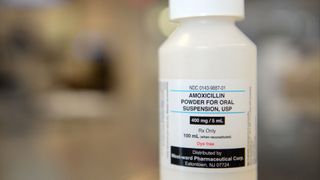Could the RSV surge be behind the amoxicillin shortage?
A surge of viral infections in the U.S. might be contributing to an ongoing amoxicillin shortage, even though antibiotics don't kill viruses.

A surge of respiratory syncytial virus (RSV) infections in U.S. babies and toddlers has coincided with an uptick in demand for certain types of amoxicillin, which, in turn, has driven shortages of the antibiotic.
Amoxicillin kills bacteria, not viruses, but there's a possibility that the RSV surge may be contributing to the drug shortage, experts told Live Science. But why would that be?
This link is plausible, in part, because RSV raises the risk of subsequent bacterial infections, including sinusitis, bacterial pneumonia and ear infections, Dr. C. Buddy Creech, a professor in the Division of Pediatric Infectious Diseases at the Vanderbilt School of Medicine in Tennessee, told Live Science in an email.
Even with this increased risk, though, it's rare for children to develop bacterial infections during or after a bout of RSV. An estimated 0.6% to 1.2% of children hospitalized with RSV bronchiolitis, which causes inflammation of the air tubes in the lungs, end up with so-called secondary bacterial infections, according to a 2017 report in the journal Pediatric Quality & Safety.
Related: New RSV vaccine given in pregnancy protects newborns from illness, Pfizer says
Similarly, influenza, whose season kicked off early this year, raises the risk of bacterial infections but still rarely occurs alongside them. In kids hospitalized with flu, the estimated rate of bacterial infection is around 2% to 4%, studies suggest.
"Far more often than not, there are no secondary bacterial infections," Creech confirmed. "With that being said, we still have to be diligent so that if symptoms of a bacterial infection emerge, we're prepared to treat it accordingly." To that end, the Centers of Disease Control and Prevention (CDC) and the American Academy of Pediatrics offer guidelines as to how to confirm the presence of a bacterial infection before giving a child antibiotics.
Sign up for the Live Science daily newsletter now
Get the world’s most fascinating discoveries delivered straight to your inbox.
Crucially, doctors are advised not to preemptively prescribe antibiotics to children with viral infections in an attempt to prevent later bacterial infections. "You wouldn't do it 'just in case,'" Dr. Francisco Alvarez, a clinical professor of pediatrics at the Stanford School of Medicine and a pediatric hospitalist at Lucile Packard Children's Hospital in California, told Live Science.
But as RSV spreads and the amoxicillin supply runs short, it raises a question as to whether doctors are overprescribing the antibiotic to kids with RSV and other viral infections.
It's possible that RSV and flu are both contributing to the shortage, but there are likely other factors at play, Alvarez said.
For one, drugmakers have little incentive to shore up their inventories of low-cost drugs, such as antibiotics, which leaves the medications vulnerable to shortages when demand spikes unexpectedly, he said. Demand for amoxicillin recently dipped, but now it's rebounded in multiple countries, leaving companies scrambling to fill orders, CNN reported. The RSV surge may have helped to reveal an existing lack of supply, Alvarez said.
Related: New discovery could help take down drug-resistant bacteria
The type of amoxicillin currently in shortage is the "oral powder for suspension," a powder that's mixed into liquid before use, the Food and Drug Administration (FDA) reported Oct. 28. However, the American Society of Health-System Pharmacists, a professional organization that also monitors drug shortages, has reported that some capsules and tablets are also in short supply.
These products are most commonly prescribed in outpatient settings, rather than in hospitals, where antibiotics can be given intravenously, said Dr. Shruti Gohil, the associate medical director of the Epidemiology and Infection Prevention program at University of California, Irvine School of Medicine and lead investigator of four INSPIRE-ASP Trials, federally funded research aimed at curbing the overuse of antibiotics in hospitals.
Outside hospitals, doctors typically don't have access to rapid diagnostic tests for bacterial infections and instead review a patient's timeline of symptoms to determine if bacteria are likely to blame, she explained.
If a doctor sees a sick child early in the course of their illness, ideally, they would wait a few days to see how the symptoms progress before considering antibiotics. But when dealing with uncertainty about a child's diagnosis, concern about whether they'll be able to return for a follow-up, and pressure from the child's caregivers, physicians may still "reach for that 'just in case' antibiotic," Gohil said.
For a patient with no bacterial infection, antibiotics can only cause problems, Dr. William Schaffner, a professor of medicine in the Division of Infectious Diseases at the Vanderbilt School of Medicine, told Live Science.
The drugs can come with side effects, such as diarrhea and skin rashes, and they disrupt the communities of bacteria that live in the gut, potentially raising the risk of later disease. And at a societal level, the overuse of antibiotics helps fuel the rise of antibiotic-resistant superbugs, Schaffner said.

Nicoletta Lanese is the health channel editor at Live Science and was previously a news editor and staff writer at the site. She holds a graduate certificate in science communication from UC Santa Cruz and degrees in neuroscience and dance from the University of Florida. Her work has appeared in The Scientist, Science News, the Mercury News, Mongabay and Stanford Medicine Magazine, among other outlets. Based in NYC, she also remains heavily involved in dance and performs in local choreographers' work.
